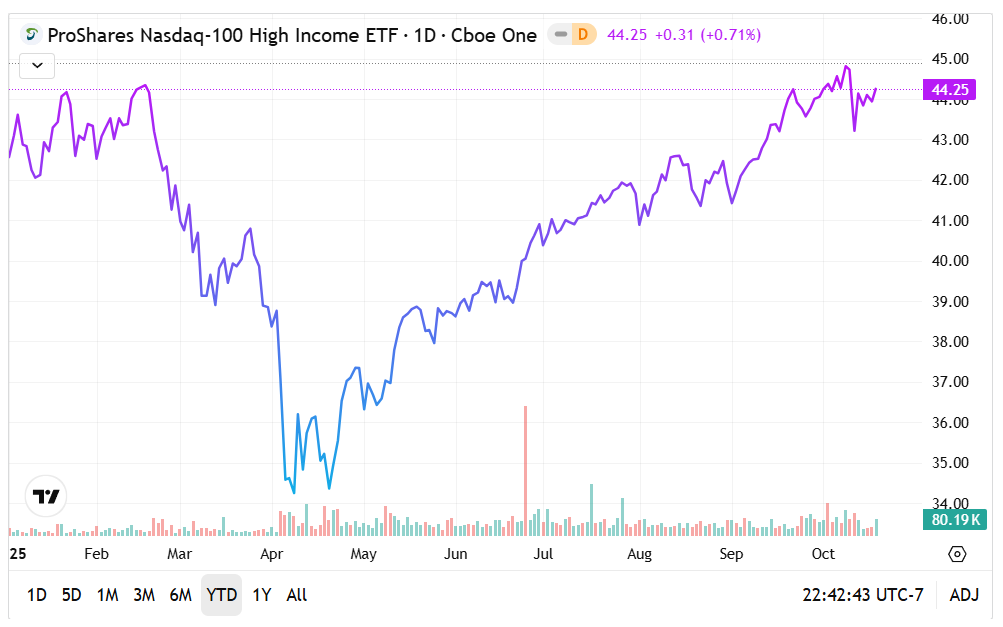
While the market seemingly features no shortage of headline-driving news, one of the most consequential developments stemmed from the Federal Reserve. In September, the central bank cut its benchmark interest rate by 25 basis points, making good on a widely expected move. Of course, gambits in monetary policy are never free, placing income-focused investors in a particularly difficult position.
One of the primary difficulties is inflation. Alongside the remarkable ascent of the technology sector was one of the oldest — gold. Certainly, the rise of the precious metals complex was no accident. Thanks in large part to persistent inflation, billionaire hedge fund manager Kenneth Griffin remarked that gold could continue to see capital inflows.
The expert isn't alone in the bullish assessment, which also assumes a sustained deterioration of relative dollar strength. Chiming in recently was economist Peter Schiff, who made the case that the yellow metal could soar past $5,000 and even $10,000. In his blue-sky forecast, Schiff believes a $20,000 gold price isn't out of the question.
Making matters more pressured for income-seeking investors, Fed Chair Jerome Powell reiterated that the central bank is still leaning toward lower rates. If so, the risk-free yield associated with U.S. Treasuries would decline, meaning that those desiring higher yields must accept more risk. Generally, this pathway entailed commercial bonds or acquiring dividend stocks tied to relatively unstable enterprises. Both approaches carry significant risks.
For more advanced traders, they can write covered calls, which is an options strategy where the market participant underwrites the risk that the target security will not rise materially to trigger assignment of the derivative contract. If it doesn't, the underwriter keeps much or all of the premium received from the debit side of the trade.
However, this income-generating strategy essentially requires the trader to own the securities under assignment risk. As well, if the calls are assigned, the underlying security is contracted to be sold at the strike price, which could lead to an absorption of opportunity costs if the stock in question continues to rise. Such strategies are then best left to experts.
The ProShares ETF: Fortunately, financial services provider ProShares provides another alternative for the income-chasing crowd with a specialized exchange-traded fund. According to the company's literature, the ProShares Nasdaq-100 High Income ETF (NASDAQ:IQQQ) targets high income potential with long-term total returns similar to the tech-heavy namesake index.
Fundamentally, what distinguishes the IQQQ ETF from other funds is its focus on robust yields. Without getting too deep into the granularity, the daily covered-call strategy is actualized through total return swap agreements with institutional counterparties. It's these counterparties that ultimately deliver the returns for IQQQ.
Another differentiating catalyst for the IQQQ ETF is that it balances high yields with what the company terms attractive long-term total return potential. To be clear, any high-yielding fund must engage in a tradeoff with capital gains potential. That's because the call options that generate the fund's income are sold to other investors — which represent the right to capture the underlying potential future gains.
While the above structure means that risk underwriters collect the premium as immediate income, this process has effectively sold part of the potential upside. What distinguishes the IQQQ ETF from competing funds is the balancing of yield and capital gains, which in part stems from volatility harvesting efficiency stemming from writing calls daily (as opposed to monthly).
Finally, a key selling point of the ProShares Nasdaq-100 High Income ETF is its monthly distributions. Since financial obligations typically occur every 30 days, the IQQQ ETF could align practically with one's lifestyle.
Despite the many conveniences of the fund, there are risks to consider. First, owning the IQQQ ETF should not be considered as a defensive or hedged strategy. If the underlying index drops sharply, the IQQQ's losses could be just as steep. Second, because of the underlying swap agreements, the process introduces counterparty exposure. Third, the distributions are not guaranteed and could fluctuate significantly depending on market conditions.
The IQQQ ETF: Since the start of this year, the IQQQ ETF has gained almost 4%. In the trailing six months, it has seen a momentum surge, up nearly 29%.
- Currently, the IQQQ's technical profile stands on solid ground, with the price action above both the 50- and 200-day moving averages.
- It's worth pointing out that despite the sharp downdraft on Oct. 10, subsequent trading has pushed the price action above the 20-day exponential moving average.
- Volume has been ticking higher relative to the lulls seen during the late summer, potentially indicating rising sentiment.

Featured image by Thomas Breher on Pixabay.







